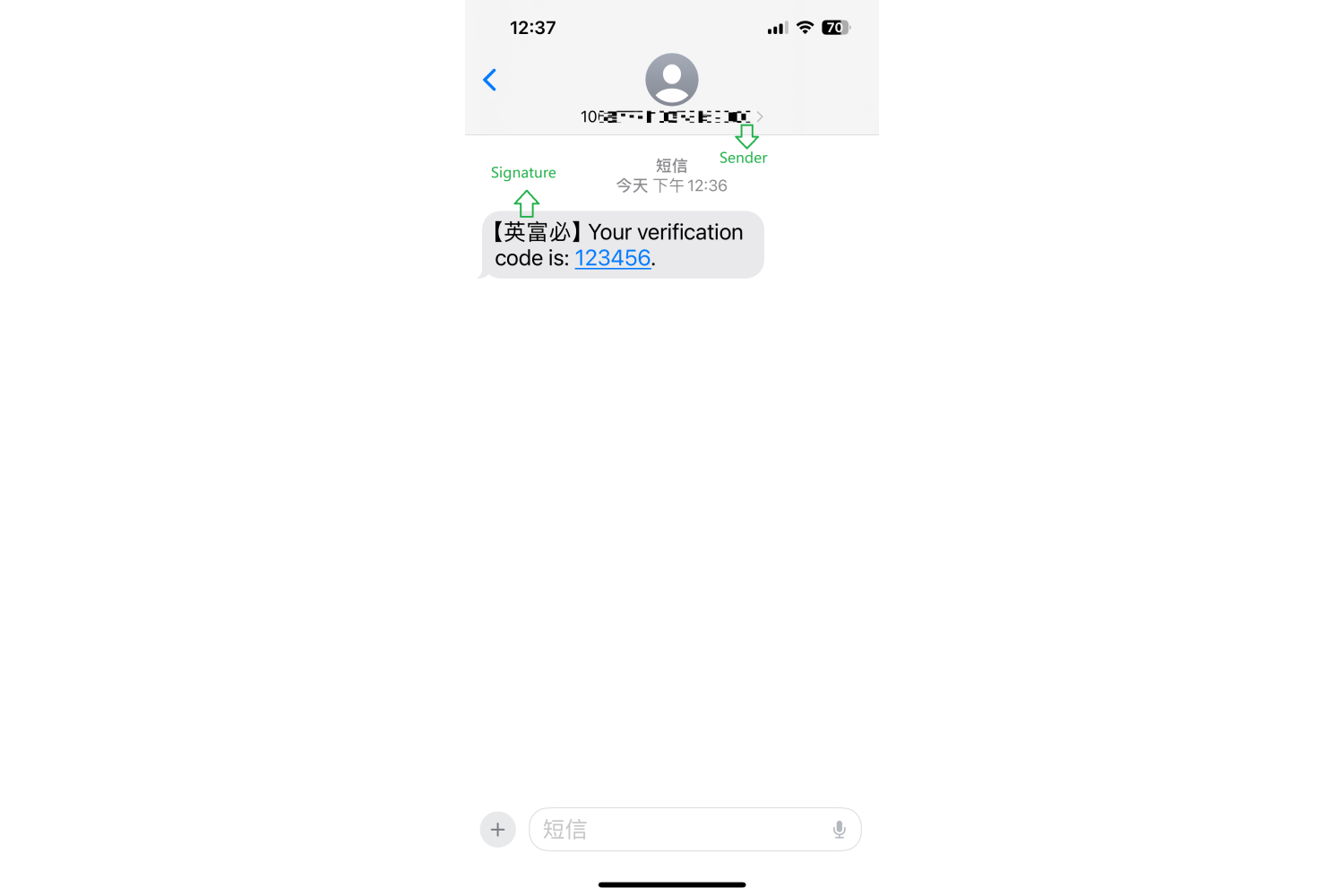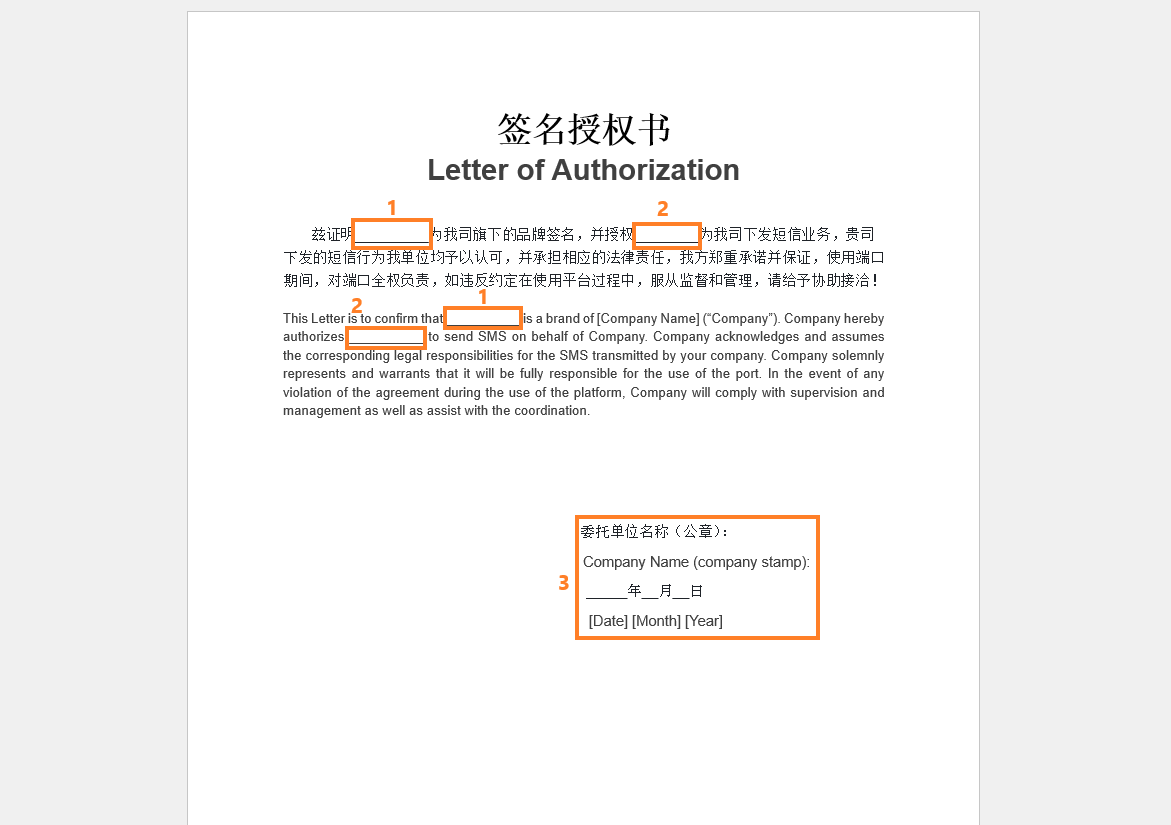China SMS registration and template guidelines
According to regulations in China, SMS messaging is restricted to Long Codes for compliance purposes. Typically, to help end-users identify message senders, signatures enclosed in Unicode【】brackets are often added at the start of a message.
Registration of templates is mandatory as any unregistered templates will be rejected. You must send an exact match of the template you have registered.
Before you begin, check the basics of China coverage, restrictions, and current regulations.
Registration requirements
The signature is one of the most important items for SMS registration in China. The signature can mirror the sender's name since only the Long Code will be displayed on the end user's handset. The signature is added by default so there is no need to add the signature in the message when sending it.
Check out the following signature restrictions:
- It is recommended for the signature to be in either Chinese characters or English letters.
- The signature can consist of 2-8 Chinese characters, with a minimum requirement of 2 characters.
- Numbers, white space, and special characters should not be included in the signature.
- The signature in English letters is unrestricted in length, but it will occupy content space, resulting in shorter characters available for other content as the name lengthens.
[ ]and【】can be used to register the signature but[ ]will be manipulated to【】once the message is delivered to the handset.- Generic signature, like
【OTP】is not allowed. It must be related to your company.

SMS content regulations
In accordance with the "Notice on Further Clarifying the Relevant Requirements for Port Short Message Services" and the "Implementation Rules for the Operation and Access Management of Port Short Message Services," issued by the Ministry of Industry and Information Technology (MIIT), new, stricter regulations have been introduced to protect user rights and improve market governance. Effective immediately, Chinese telecom operators will enforce tighter controls on SMS content.
All telecom networks across China and its administrative regions are required to promptly implement these regulations, which are designed to clean up and regulate the SMS service market. As a result, there may be instances where traffic is blocked without prior notice, potentially affecting legitimate and registered customer traffic. To help mitigate potential issues, we are providing the following key information for our customers.
Documentation requirements
For both international and local clients handling financial and non-financial traffic, the following documentation is required:
-
China business license issued by the mainland China government
-
China citizen ID
-
Tax number
-
Contract between Infobip and client (first and stamped pages), or a Letter of Authorization (LOA)
-
签名授权书 - Letter of Authorization - Bilingual (opens in a new tab)
- Signature you wish to register for your SMS traffic.
- If you are a direct client, enter "Infobip" as the recipient. For resellers/wholesale clients, please provide the full chain of LOAs, including the one from the end client to the reseller and another from the reseller to Infobip.
- Company name, company stamp, and the validity date of the LOA.

Non-financial customers
If clients are unable to provide the required documentation, some suppliers may, on a case-by-case basis, accept the following alternatives:
- Overseas business license
- Passport
- Chain LOA and other documents that demonstrate economic activity in China
You may use the provided LOA template.
Note that the acceptance of these alternative documents by operators is not guaranteed.
Financial customers
Please prepare the following information, as it will be required during the registration process in addition to the documents:
- Official website
- Company (entity) name
- Type of traffic (for example, transactional, OTP, promotional)
- Message content
- Sender name (which will be assigned a random VLN) and signature
If clients cannot provide the required documents, they have the option to use a generic signature for pure OTP only.
Generic sender and signature
If clients cannot provide the required documents, you may opt to use a generic sender and signature for SMS traffic. To proceed, you must provide all message templates as they need to be safelisted by the operators.
Key points
- Generic senders/signatures are shared across multiple clients, instead of using unique client-specific ones.
- Clients may include their brand name within the message content, but this is subject to approval, as certain words (especially related to financial topics) are blocked by Mobile Network Operators (MNOs).
- Suppliers provide these generic senders/signatures to Infobip, excessive or abusive use (spamming) of generic signatures may result in the service being blocked for all clients.
- Generic senders/signatures are strictly limited to pure OTP for financial customers and OTP/transactional traffic for non-financial customers.
Contact cpaas_registrations@infobip.com for more information on the available generic signatures.
Template registration
For template registration, provide all the templates you intend to use. You may submit them via an Excel document. Be sure to highlight the variables that are not fixed and can be personalized based on the recipient of the SMS.
Example: "XXXX is your OTP," where "XXXX" will change depending on the situation.
Once all requirements and documents are completed, you can:
- Direct customers (end customers) - start the Sender ID registration process here (opens in a new tab), and click the Request Sender button under Alphanumeric Sender ID. Provide the necessary details and submit the request.
- Wholesales/partner - contact wholesale_registrations@infobip.com and your dedicated account manager, and provide the documents along with the required sender information.